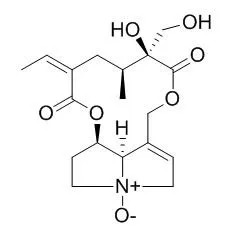| In vitro: |
| Mutat Res. 1992 Jul;282(3):169-76. | | The clastogenic potential in vitro of pyrrolizidine alkaloids employing hepatocyte metabolism.[Pubmed: 1378549] | Three pyrrolizidine alkaloids (PAs), monocrotaline, retrorsine and Isatidine, were tested for their clastogenic activity under different conditions of metabolic activation in vitro.
METHODS AND RESULTS:
All three compounds exhibited a weak activity when V79 cells were treated at very high concentrations for 18 h in the absence of a metabolizing system. Short-term (2 h) treatment with rat liver S9 mix led to a strong and concentration-dependent increase in chromosomal aberrations for retrorsine. Isatidine was not mutagenic with S9 mix and monocrotaline was positive at high concentrations only. In contrast, a prolonged treatment (18 h) in vitro under activation conditions in the presence of primary hepatocytes led to clear concentration-dependent positive responses for all three PAs investigated. Particularly the results with Isatidine demonstrate that in vitro tests using S9 mix for metabolization can generate misleading results. It is not clear whether the results could be attributed to a better activation of the test compounds by intact hepatocytes in comparison to S9 mix or if the fact that only hepatocytes allow a treatment for the whole culture period under activation conditions was more important. Owing to its strong cytotoxicity the exposure to S9 mix is generally limited to 2-4 h, limiting also the exposure of the target cells to a test chemical as well as its metabolites.
CONCLUSIONS:
The results presented show significant differences in mutagenic potency of PAs due to variations in the activation system. This underlines the usefulness of primary hepatocytes, e.g., for the detection of pre-mutagens. The PAs investigated are present in plants which are used for phytotherapeutic medicinal products. They do not contribute to their efficacy and are, therefore, not to be tolerated in amounts that may impose a risk for the user. | | Anticancer Res. 2001 Jan-Feb;21(1A):461-9. | | Micronucleus formation in human lymphocytes and in the metabolically competent human hepatoma cell line Hep-G2: results with 15 naturally occurring substances.[Pubmed: 11299780 ] |
METHODS AND RESULTS:
To examine the concordance of two metabolizing systems for use in genotoxocity testing with the micronucleus test, 15 naturally occurring substances (arecoline, the plant extract aristolochic acid, beta-asarone, benzyl acetate, coumarin, emodine, Isatidine dihydrate, monocrotaline, psoralen, reserpine, retrorsine, safrole, sanguinarine chloride, tannin and thiourea) were tested for their genotoxicity in the cytokinesis-block micronucleus test in vitro with human lymphocytes and in the presence and the absence of an exogenous metabolizing system from rat liver S9-mix and the metabolically competent human hepatoma cell line Hep-G2. Arecoline, the plant extract aristolochic acid, psoralen and tannin caused a significant increase in the number of micronuclei in human lymphocytes in the presence and the absence of an exogenous metabolising system from rat liver S9-mix and the metabolically competent human hepatoma cell line Hep-G2.
A significant increase in the number of micronuclei with beta-asarone, coumarin, monocrotaline and retrorsine could be detected in the presence of S9-mix and the cell line Hep-G2.
CONCLUSIONS:
Benzyl acetate, emodine, Isatidine dihydrate, reserpine, safrole, sanguinarine chloride and thiourea did not reveal any micronucleus inducing activity in either human lymphocytes or in Hep-G2. In addition to the other Hep-G2 results in the literature, this human hepatoma cell line could have a useful potential in the in vitro micronucleus test. |
|






 Cell. 2018 Jan 11;172(1-2):249-261.e12. doi: 10.1016/j.cell.2017.12.019.IF=36.216(2019)
Cell. 2018 Jan 11;172(1-2):249-261.e12. doi: 10.1016/j.cell.2017.12.019.IF=36.216(2019) Cell Metab. 2020 Mar 3;31(3):534-548.e5. doi: 10.1016/j.cmet.2020.01.002.IF=22.415(2019)
Cell Metab. 2020 Mar 3;31(3):534-548.e5. doi: 10.1016/j.cmet.2020.01.002.IF=22.415(2019) Mol Cell. 2017 Nov 16;68(4):673-685.e6. doi: 10.1016/j.molcel.2017.10.022.IF=14.548(2019)
Mol Cell. 2017 Nov 16;68(4):673-685.e6. doi: 10.1016/j.molcel.2017.10.022.IF=14.548(2019)